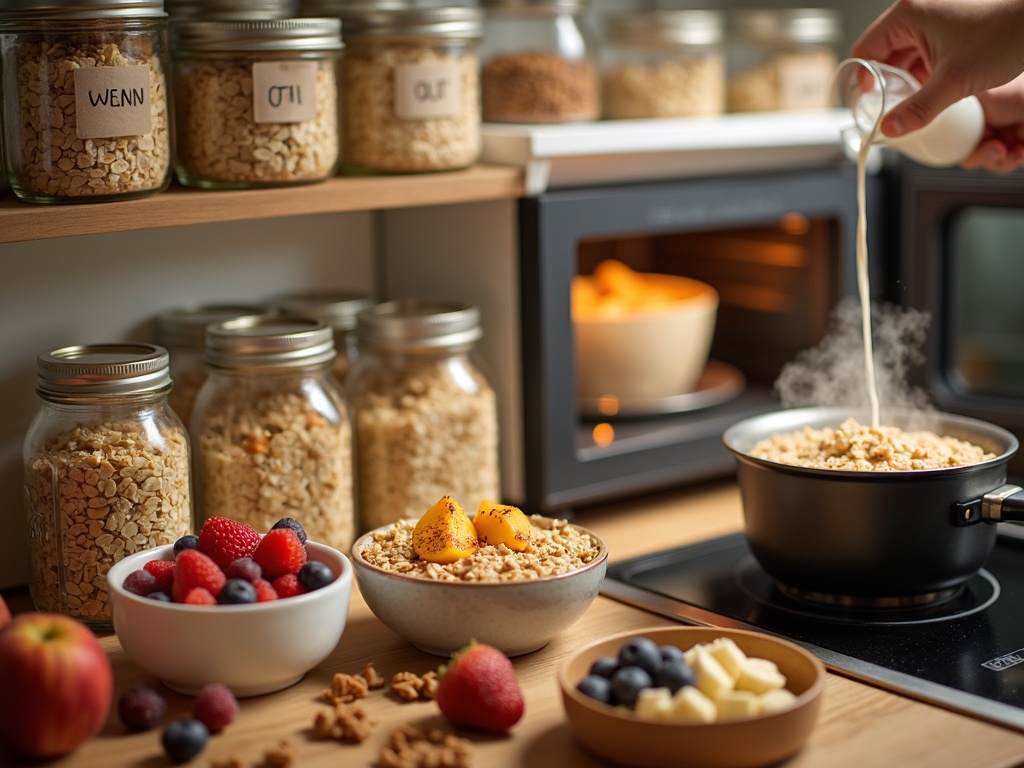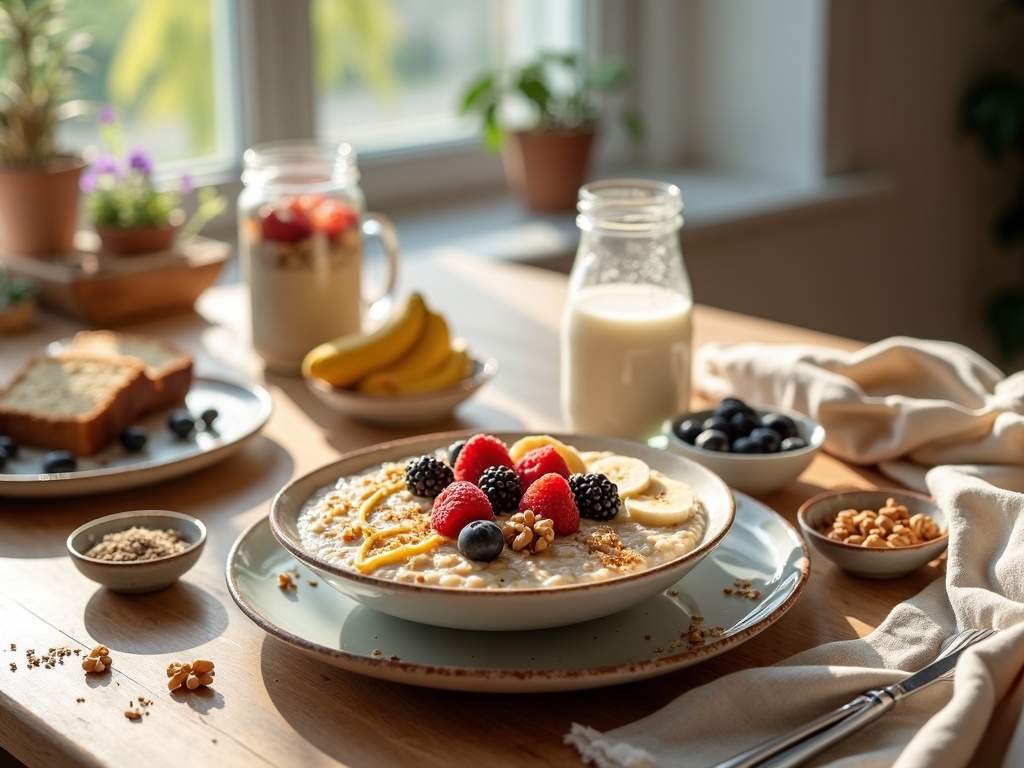Oats recipe offer a versatile and nutritious breakfast option that I can customize with countless flavor combinations and prepare in just 10 minutes. This humble grain packs impressive health benefits, including heart-healthy fiber, quality protein, and sustained energy, while its adaptability allows for both sweet and savory preparations to suit any preference.
Find In This Article
Key Takeaways
- Oats provide exceptional nutritional value with fiber, protein, and heart health benefits at an economical price point.
- The standard cooking ratio is 1 cup of rolled oats to 2 cups of liquid, with a pinch of salt to enhance flavor.
- Proper cooking technique involves gentle simmering on medium-low heat with occasional stirring to achieve a creamy texture.
- Toasting oats before cooking and choosing milk instead of water can significantly enhance flavor and texture.
- Cooked oatmeal can be stored in the refrigerator for up to 5 days, making it perfect for efficient meal prep.
Health Benefits of Oats
Starting my day with a bowl of oats gives me more than just a satisfying breakfast. These humble grains pack a powerful nutritional punch that supports overall wellness in multiple ways.
Nutritional Powerhouse
Oats stand out as one of the most fiber-rich grain options available. A single cup provides about 8 grams of dietary fiber, including beta-glucan, a soluble fiber that helps control blood sugar levels and promotes digestive health. This makes oats an excellent choice for anyone looking to increase their daily fiber intake.
The protein content in oats is equally impressive. Unlike many other grains, oats contain a higher proportion of quality protein, providing approximately 5 grams per cup. This makes them particularly valuable for vegetarians or those trying to reduce meat consumption while maintaining adequate protein levels.
Heart health benefits are another compelling reason to include oats in your diet. Regular consumption has been linked to lower cholesterol levels, particularly the harmful LDL cholesterol. The beta-glucan fiber binds with cholesterol-rich bile acids in the intestine and helps remove them from the body.
What sets oats apart from many breakfast options is their ability to provide sustained energy. The complex carbohydrates in oats break down slowly, preventing the blood sugar spikes that can leave you feeling hungry shortly after eating. When I enjoy a hearty oat breakfast, I stay fuller longer and maintain consistent energy levels throughout the morning.
For those watching their budget, oats offer exceptional nutritional value at a fraction of the cost of many processed breakfast options. A large container of plain oats costs just a few dollars and provides numerous servings, making it one of the most economical ways to start the day with proper nutrition.
The versatility of oats also means they can be incorporated into countless recipes beyond breakfast. I often add them to banana bread recipes for extra texture and nutrition, or use them as a base for savory dishes. Their mild flavor adapts well to both sweet and savory preparations, making them easy to include in various meals throughout the day.
For a delicious treat that still delivers nutritional benefits, oats form the foundation of classic ANZAC biscuits, proving that even desserts can contain wholesome ingredients.
Time Needed
The beauty of oats recipes lies in their efficiency – I’ve perfected a preparation process that takes just 10 minutes from start to finish. This quick turnaround makes oats an ideal breakfast option even on the busiest mornings when time feels particularly scarce.
Preparation Breakdown
When preparing oats, I find it helpful to think of the process in distinct phases that can be completed quickly:
- Gathering ingredients: 1–2 minutes (less if you prep the night before)
- Measuring oats and liquid: 1 minute
- Cooking time: 5–7 minutes for stovetop oats; 1–2 minutes for microwave versions
- Adding toppings and mix-ins: 1 minute
The simplicity of this process reminds me of making fluffy American pancakes – straightforward yet rewarding. What makes oats particularly convenient is that you can multitask during the cooking phase, perhaps preparing your coffee or packing lunch while occasionally stirring the pot.
I’ve found that steel-cut oats require slightly more cooking time (about 15–20 minutes total), but overnight versions eliminate morning cooking altogether. For those days when even 10 minutes feels like a luxury, consider making a larger batch on weekends – cooked oats store well in the refrigerator for 3–4 days.
Using the microwave can cut your time investment even further. Simply combine oats and liquid in a microwave-safe bowl, heat for 90 seconds, stir, and heat for another 30 seconds if needed. This method is perfect for office breakfasts or dorm rooms.
For something different that maintains the quick preparation time, try a no-cook banana bread-inspired overnight oats version. The preparation takes just 5 minutes in the evening, and breakfast is ready immediately upon waking.
The 10-minute timeframe also allows for personalization:
- Toast nuts for 2–3 minutes to enhance flavor
- Slice fresh fruit
- Create a quick compote by simmering berries with a touch of honey for 3–4 minutes while your oats cook
What I appreciate most about this short preparation time is how it provides a healthy breakfast option without requiring early morning effort. Unlike elaborate breakfast recipes that might demand 30+ minutes, oats deliver similar nutritional benefits in just a fraction of the time.
For parents, this quick cooking time is particularly valuable – you can prepare a nutritious breakfast for the whole family and still get everyone out the door on schedule. The process is simple enough that older children can even learn to make their own oats, fostering independence while ensuring they start their day with proper nutrition.
Much like making a simple strawberry shortcake, the brief time investment yields disproportionately delicious results. Ten minutes is all that stands between you and a warm, comforting bowl of oats that can be customized to suit any preference or dietary need.

Serving Size
This oats recipe makes 2 generous portions, perfect for a cozy breakfast shared with someone special or for meal prepping your weekday morning meals. I’ve carefully proportioned the ingredients to give you just the right amount without any waste.
Adjusting Portions for Different Needs
When preparing this recipe, you can easily scale it up or down depending on your specific requirements:
- For a single serving: Simply halve all the ingredients for a quick solo breakfast
- For a family of four: Double the recipe for a hearty start to everyone’s day
- For meal prep: Keep the recipe as is for two days of ready-to-go breakfast
If you’re planning to prepare multiple servings for the week ahead, consider making a larger batch of the dry ingredients and storing them in an airtight container. This approach works particularly well with overnight oats recipes that can be prepared in advance.
For those who enjoy heartier portions, this recipe offers flexibility. The standard serving provides approximately 350–400 calories per portion, but you can adjust the toppings to increase or decrease the caloric content based on your dietary needs.
I’ve found that these portions work exceptionally well when paired with fresh fruit. You might also consider serving alongside a small slice of banana bread for a more substantial breakfast option.
Remember that oats tend to expand as they cook or soak, so what might initially seem like a small amount of dry oats will grow considerably once prepared. Each portion typically fills a standard cereal bowl or mason jar comfortably, giving you a satisfying meal without feeling overly heavy.
Essential Ingredients for Perfect Oats
Starting your day with a warm bowl of oatmeal isn’t just satisfying—it’s nutritionally smart too. I’ve found that gathering the right ingredients before cooking makes all the difference between a bland breakfast and a delicious, energy-boosting meal that keeps me full until lunch.
Base Ingredients
The foundation of any good oats recipe begins with quality rolled oats. You’ll need 1 cup of rolled oats as your starting point. These aren’t just any grain—they’re packed with fiber, protein, and essential nutrients that provide sustained energy throughout your morning. Unlike instant oats, rolled oats maintain more texture when cooked, giving your breakfast that perfect consistency.
For the liquid component, you’ll need 2 cups of either water or milk. Water creates a lighter breakfast, while milk (dairy or plant-based) delivers a creamier texture and added protein. The standard ratio of 1:2 (oats to liquid) produces that ideal porridge consistency, though you can adjust this slightly based on how thick you prefer your oatmeal.
Don’t forget a pinch of salt! This small addition might seem unnecessary in a sweet dish, but it actually enhances the natural flavor of the oats. Just like when making fluffy American pancakes, salt balances sweetness and brings out subtle grain flavors.
Flavor Enhancers and Toppings
Once you’ve mastered the base, it’s time to transform your oats from basic to extraordinary with these additions:
- Optional sweeteners: A drizzle of honey or maple syrup adds natural sweetness without overpowering the oats. Start with a tablespoon and adjust to taste.
- Fresh fruits: Berries, sliced bananas, diced apples, or peaches add natural sweetness, texture, and nutritional value. For a warming treat similar to homemade peach crisp, try adding cinnamon and baked fruit.
- Nuts and seeds: Almonds, walnuts, chia seeds, or flaxseeds introduce protein, healthy fats, and a satisfying crunch. They not only improve texture but also slow digestion, keeping you fuller longer.
- Spices: Cinnamon, nutmeg, or cardamom can transform your oatmeal into something special. Just a quarter teaspoon is enough to infuse warmth throughout your bowl.
The beauty of oatmeal lies in its versatility. I often make a large batch at the beginning of the week, similar to how I prepare banana bread for grab-and-go breakfasts. By preparing the base and storing it in the refrigerator, I can quickly reheat portions and add fresh toppings each morning.
For those with a sweet tooth, try creating an oatmeal-based dessert by adding chocolate chips, coconut flakes, or a spoonful of nut butter. This approach satisfies cravings while still delivering nutritional benefits—something I appreciate when making treats like ANZAC biscuits that also use oats as a base ingredient.
During summer months, overnight oats provide a refreshing alternative. Simply combine your base ingredients in a jar, refrigerate overnight, and top with fresh strawberries or other seasonal fruits in the morning.
For a savory twist, skip the sweeteners and top your oats with a fried egg, avocado slices, and a sprinkle of cheese. This variation offers the same nutritional benefits while delivering a completely different flavor profile—perfect for those who prefer savory breakfasts.
Whatever variations you choose, starting with these essential ingredients ensures your oatmeal will be both nutritious and delicious every time.
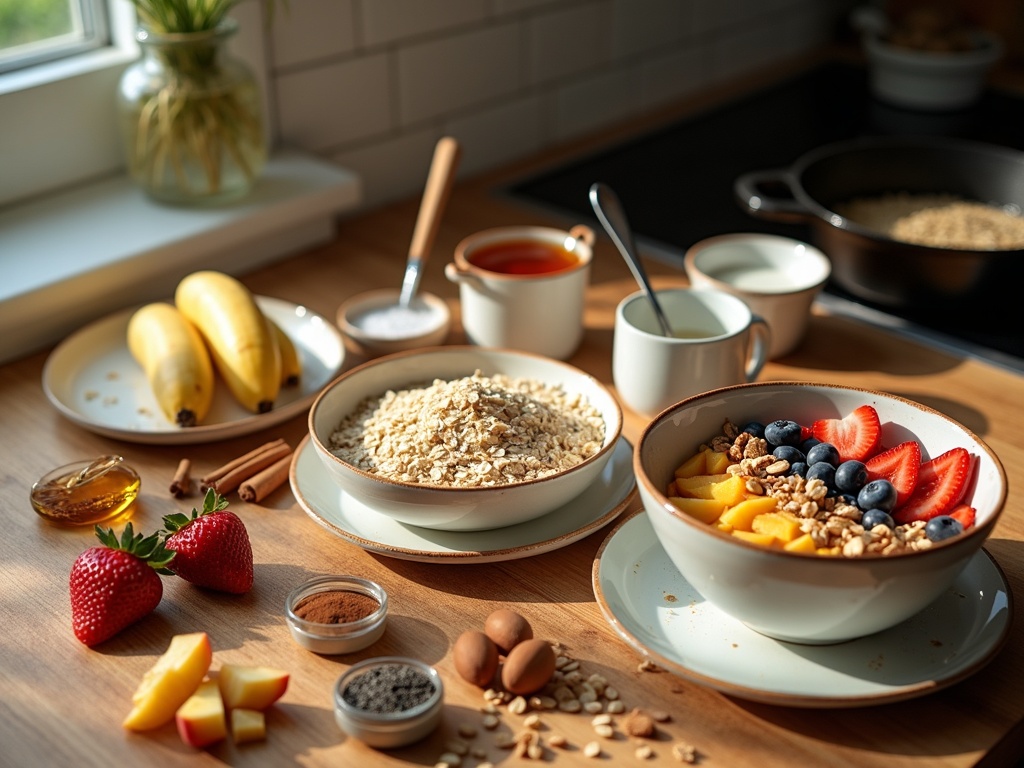
How to Make Creamy Oatmeal
Creating the perfect bowl of creamy oatmeal doesn’t require professional culinary skills, just a few simple steps that make all the difference. I’ve perfected this technique over time, and it delivers consistent results every morning. The secret lies in the cooking process and timing.
Step-by-Step Cooking Process
First, select your liquid of choice. Water works perfectly fine, but milk (dairy or plant-based) creates a creamier texture. For one serving, I recommend using 1 cup of liquid for every ½ cup of rolled oats.
Pour your chosen liquid into a small saucepan and bring it to a rolling boil over medium-high heat. This initial high temperature helps break down the oats properly when they’re added.
Once the liquid reaches a boil, add your oats and a pinch of salt. The salt might seem optional, but it’s actually crucial – it enhances the natural flavor of the oats and balances any sweetness you might add later.
Immediately reduce the heat to low, allowing the mixture to simmer gently. This slower cooking method prevents the oatmeal from becoming gluey or sticking to the bottom of the pan.
Stir the oatmeal occasionally during the cooking process, about every minute or so. This prevents clumping and helps create that smooth, creamy texture that makes breakfast favorites like this so satisfying.
Let the oats simmer for approximately 5–7 minutes. The exact timing depends on:
- The type of oats you’re using (steel-cut will take longer than rolled)
- Your preferred consistency
- The heat level of your stove
You’ll know the oatmeal has reached the right consistency when it’s thickened but still slightly loose – it will continue to thicken after being removed from heat.
Once you’ve achieved your desired consistency, remove the pot from the heat completely. Let the oatmeal stand for about 2 minutes. This resting period allows the oats to absorb any remaining liquid and reach their final, perfect texture.
Now comes the fun part – adding your favorite toppings! Sweet options might include:
- Fresh or dried fruits
- Honey or maple syrup
- Nuts and seeds
- Cinnamon or other spices
For a savory twist, try adding:
- A fried egg
- Avocado
- Sautéed mushrooms
- Grated cheese
For extra creaminess, stir in a spoonful of nut butter similar to what’s used in baking or a splash of cream just before serving.
This simple method creates oatmeal that’s worlds apart from instant varieties. The texture is silky and comforting, without any of the gluey consistency that can happen with rushed cooking. I find this approach takes just a few minutes longer than instant options but delivers a significantly more satisfying breakfast that keeps me full until lunch.
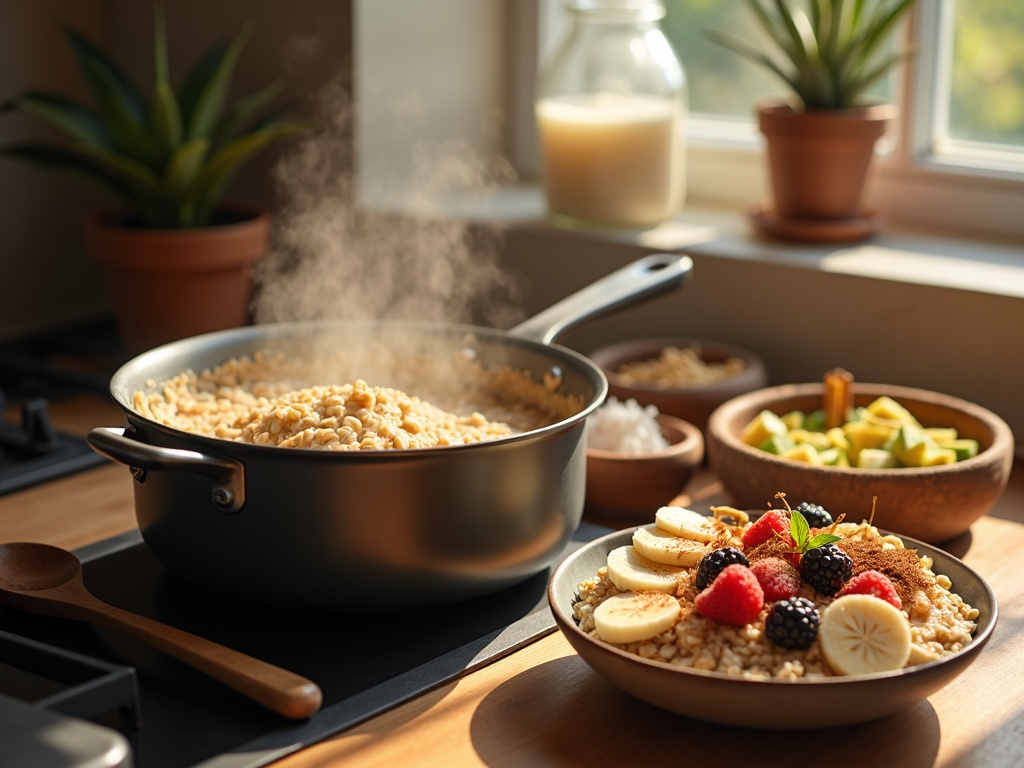
Delicious Topping Combinations
I’ve discovered that the right toppings can transform a simple bowl of oats into a gourmet breakfast experience. The beauty of oatmeal lies in its versatility as a canvas for countless flavor combinations. Let me share some of my favorite topping combinations that’ll make your morning oats irresistible.
Sweet and Fruity Inspirations
The Berry Blast combination brings vibrant flavors to your breakfast bowl. I like to add a generous handful of mixed berries—strawberries, blueberries, and raspberries—topped with a drizzle of honey. The natural sweetness of berries pairs perfectly with the nutty flavor of oats, creating a breakfast that’s both nutritious and satisfying. This topping works wonderfully with fluffy American-style pancakes too!
For a classic comfort food experience, try the Banana Nut variation. Simply add sliced bananas and crushed walnuts to your oatmeal. The bananas add natural sweetness while the walnuts provide a satisfying crunch and healthy fats. If you’re a fan of banana-based treats, you might enjoy applying this same flavor profile to a homemade banana loaf as well.
The Apple Pie topping brings the cozy flavors of fall to your breakfast bowl. Add diced apples sautéed with cinnamon for a warming treat that feels indulgent but remains wholesome. The apples become slightly soft while maintaining a pleasant texture, and the cinnamon adds that signature apple pie flavor. This combination reminds me of a simpler version of peach crisp’s delightful fruit and spice pairing.
For something more exotic, the Tropical topping combines diced mango and coconut flakes for a breakfast that feels like a mini vacation. The sweet, juicy mango chunks bring brightness, while coconut flakes add texture and a hint of indulgence. This combination works particularly well with overnight oats for a refreshing summer breakfast option.
These topping combinations offer variety to keep your oatmeal exciting day after day. I find that preparing the ingredients the night before saves precious morning time. For fruits like apples and mangoes, a quick dice is all that’s needed, while berries can be used whole or sliced depending on their size.
Don’t be afraid to mix and match these ideas to create your own signature oatmeal bowl. The possibilities are nearly endless, making oats one of the most adaptable breakfast options for any taste preference or season.
Common Mistakes to Avoid
Creating perfect oatmeal might seem straightforward, but there are several pitfalls that can turn your nutritious breakfast into a disappointing mess. I’ve made these mistakes myself and learned the hard way how to fix them.
Recipe Pitfalls That Ruin Your Oats
Getting the oat-to-liquid ratio wrong tops the list of oatmeal missteps. Too much liquid results in soupy oats that lack texture, while too little creates a dry, dense breakfast that’s hard to enjoy. For rolled oats, I stick to a 1:2 oat-to-liquid ratio as a starting point, adjusting slightly based on my desired consistency.
Cooking temperature matters significantly when preparing oatmeal. High heat might seem like a time-saver, but it often leads to oats that stick to the bottom of the pan or boil over, creating a messy stovetop. Instead, I cook my oats on medium-low heat, allowing them to simmer gently until they reach the perfect creamy texture. This approach works beautifully when making oat-based breakfast alternatives too.
Many people skip adding salt to their oatmeal, but this tiny addition makes a massive difference. Just a pinch enhances the natural flavor of oats without making them taste salty. Salt provides a necessary contrast that brings out the oats’ subtle nuttiness, similar to how it works in quick bread recipes.
Stirring technique can make or break your oatmeal. Overstirring releases too much starch, creating a gummy texture rather than the desired creamy consistency. I stir occasionally just to prevent sticking, especially when adding ingredients like those found in traditional oat biscuits.
The timing of adding toppings is another crucial factor. Adding fruit, nuts, or sweeteners too early can result in soggy additions or flavors that disappear during cooking. I add these elements right before serving to maintain their texture and distinct flavors. Sweet toppings like those used in fruit crisps work best when they contrast with the cooked oats rather than melding into them.
By avoiding these common mistakes, your morning oatmeal will transform from basic to brilliant. The secret isn’t fancy ingredients or complicated techniques – it’s simply respecting the cooking process and understanding how oats respond to different treatment.
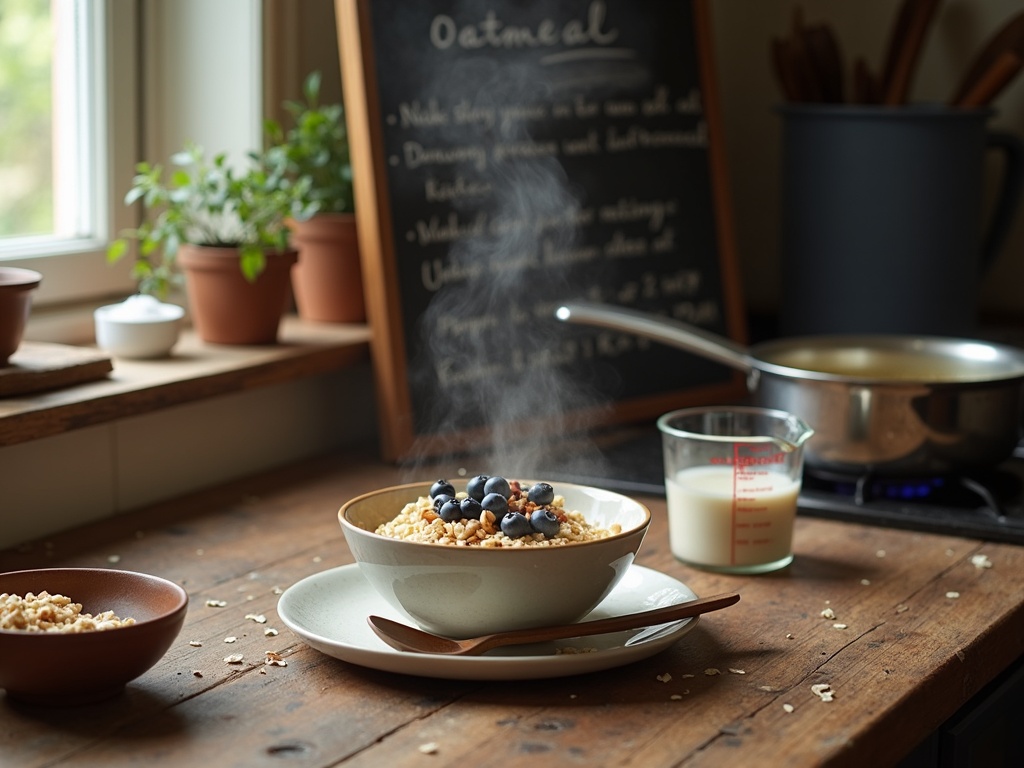
Pro Tips for Perfect Oatmeal
Perfect oatmeal isn’t just about following a basic recipe—it’s about understanding techniques that elevate this humble grain to something extraordinary. I’ve discovered several methods that make a dramatic difference in both flavor and texture.
Enhancing Flavor and Texture
Toasting oats before cooking is a game-changer that many home cooks overlook. Simply spread your oats on a baking sheet and toast them for 5–7 minutes at 350°F until they become slightly golden and fragrant. This quick step adds a nutty depth that transforms ordinary oatmeal into something special. It works particularly well with steel-cut oats, which develop an even richer flavor profile when toasted.
The liquid you choose makes a significant difference in your final product. While water works fine, using milk creates a creamier, more luxurious texture. I prefer whole milk for maximum creaminess, but any milk variety works well—including plant-based options like almond or oat milk. For an extra indulgent breakfast, try a splash of half-and-half or coconut milk stirred in at the end of cooking.
Meal prep enthusiasts will love that oatmeal can be made ahead and reheated without sacrificing quality. I often make a large batch that lasts several days. When reheating, add a splash of liquid to restore the creamy consistency. This approach saves significant time on busy mornings and pairs wonderfully with homemade banana bread for a complete breakfast.
Creative Variations
Savory oatmeal offers a refreshing break from sweet preparations. Try these savory twists:
- Cook oats in vegetable or chicken broth instead of water
- Top with a fried egg, avocado, and hot sauce
- Add sautéed mushrooms, spinach, and a sprinkle of Parmesan
- Incorporate miso paste and top with green onions
- Stir in pesto and top with cherry tomatoes
Proper storage is crucial for maintaining freshness. Store cooked oatmeal in airtight containers in the refrigerator for up to 5 days. For longer storage, portion cooled oatmeal into freezer-safe containers or silicone muffin cups, then freeze. This method creates convenient single servings that can be thawed overnight in the fridge or quickly warmed in the microwave.
For those who enjoy sweet variations, strawberry toppings or fresh peaches make excellent seasonal additions that brighten up your morning bowl without excessive added sugar.
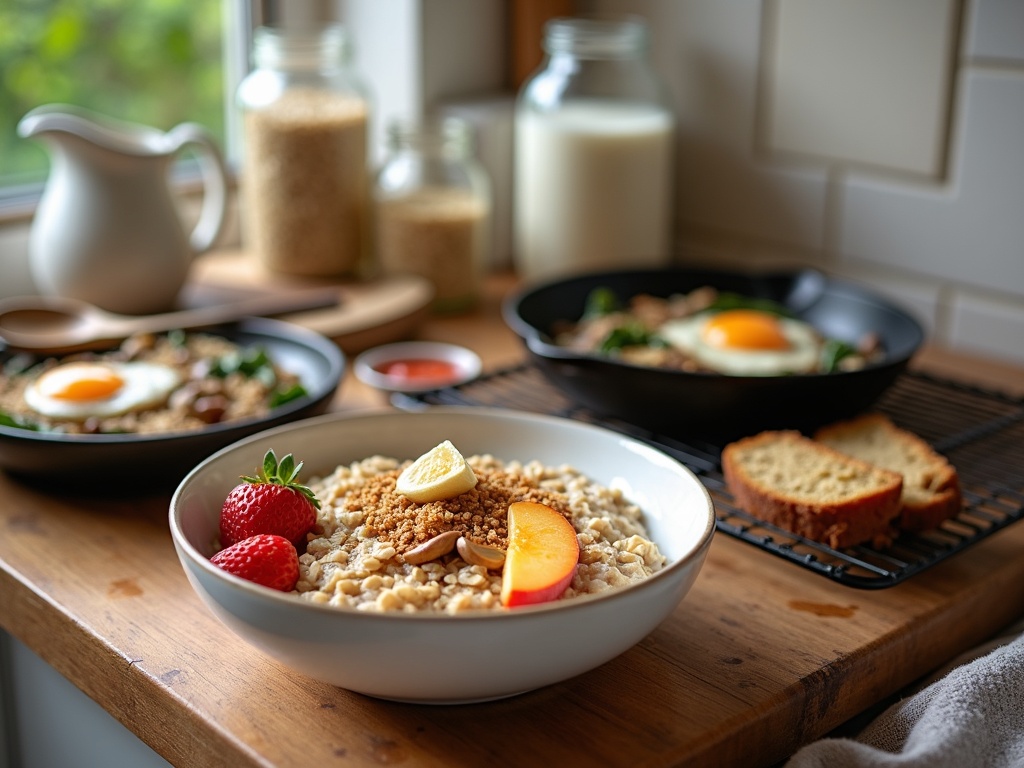
Storage and Reheating
Preparing oats ahead of time can save precious morning minutes while still ensuring a nutritious start to your day. I’ve found that properly stored oats maintain their delicious flavor and texture for days, making them perfect for meal prep.
Refrigerator Storage Tips
Once cooked, oats can be safely stored in the refrigerator for up to 5 days. For best results, allow the oatmeal to cool completely before transferring it to an airtight container. Glass containers work particularly well as they don’t absorb odors from the oatmeal or other foods in your fridge. If you’re making individual portions, consider using mason jars or small containers for grab-and-go breakfasts. This method works great with overnight oats recipes too, which don’t require cooking at all.
Reheating Methods
Cold oatmeal from the fridge will thicken considerably, so adding liquid is essential when reheating. Add a splash of milk (dairy or plant-based) to restore the creamy consistency before reheating. The microwave offers the quickest method—place your oatmeal in a microwave-safe bowl and heat in 30-second intervals. Stirring between each interval prevents hot spots and ensures even heating throughout.
For the best texture, don’t rush the reheating process. Overheating can make oatmeal gummy, while gentle warming preserves its appealing consistency. If your oatmeal seems too thick even after adding milk, don’t hesitate to add more until you reach your desired consistency.
You can also reheat oatmeal on the stovetop. Add your refrigerated oatmeal to a small saucepan with a splash of milk, then warm over medium-low heat while stirring frequently. This method gives you more control over the consistency and temperature.
Reheated oatmeal makes a perfect canvas for fresh toppings:
- Add fruits, nuts, and sweeteners after reheating to keep them fresh and crunchy.
- Try incorporating elements from a banana bread recipe by adding mashed banana, cinnamon, and walnuts.
- Frozen fruits like berries or sliced peaches pair wonderfully—warm oats thaw them naturally and release their juices into the bowl.
With a few simple steps, you can enjoy a warm, nourishing breakfast all week long without compromising on taste or texture.
